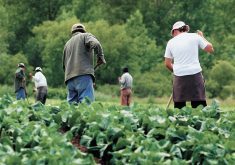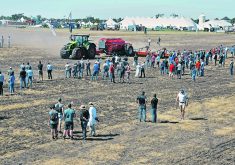About three million Canadians lost their jobs last spring as COVID-19 forced thousands of businesses to shut their doors or lay off staff.
Meanwhile, many farmers needed employees last spring and summer, but few Canadians applied for farm jobs, despite record levels of unemployment across the country.
A survey of farm operators has found that 41 percent of producers could not recruit a sufficient number of workers in 2020.
As well, fewer Canadians were interested in the available work.
“Seventy-one percent of employers (farmers) who reported labour shortages cited fewer Canadian applicants,” said the Canadian Agricultural Human Resource Council (CAHRC), in a report released April 6.
Read Also

Rented farmland jumps 3.4 million acres in Saskatchewan and Alberta
Farmland rented or leased in the two provinces went from 25.7 million acres in 2011 to 29.1 million in 2021, says Census of Agriculture data.
The report, Understanding the Effects of COVID-19 on Canada’s Agriculture Workforce, was based on a survey of 450 farm businesses and detailed interviews with 20 farmers, carried out last fall and this winter.
CAHRC hired the Conference Board of Canada to conduct the research.
The survey found that Canadian farmers lost out on earnings worth $2.9 billion because of labour shortages connected to COVID-19. The $2.9 billion represents 4.2 percent of total agricultural sales in 2020.
As for labour shortages, the CAHRC report said:
- Two in five employers (41 percent) experienced labour shortages during COVID-19.
- Most employers (86 percent) who reported labour shortages believe that COVID-19 contributed to their shortages.
Of all crops and commodities produced on Canadian farms, COVID had the biggest impact on fruit and vegetable growers, and beekeepers.
About 55 percent of farmers in horticulture said they couldn’t find enough workers. About half of beekeepers (47 percent) couldn’t hire enough employees.
Both of those sectors are highly dependent on temporary foreign workers. On many of Western Canada’s apiaries, about half (or a larger share) of the employees are from the Philippines, Mexico or Central America.
Thousands of TFWs weren’t permitted into Canada, or their arrival was delayed, because of COVID-19 protocols and cancelled flights last spring.
The difficulties of getting TFWs to Canada and migrant workers becoming infected with COVID-19 on Canadian farms became a major issue in 2020.
Yet through these events, Canadians weren’t interested or willing to work on farms, despite jobs being available.
Farmers told the Conference Board of Canada that many Canadian applicants were seeking part-time work.
“This could be related to applicants wanting to maintain low enough working hours to qualify for CERB (a $500 a week program for workers affected by COVID-19),” farmers told the Conference Board.
A vegetable grower in Quebec summarized the frustrations of many farmers.
“We have received 80 names…. Of those 80 people, 25 showed up and stayed for more than 24 hours. All of the others basically did not want to work… did not want to work more than 19 hours (so that they could keep their CERB). They did not want to work early in the morning or late at night and they did not want to work on weekends,” said Anne Verny in the CAHRC report.
About half of the 450 producers in the survey said they want help in finding and retaining Canadian workers.
Some Canadians may be unwilling to work long days or on weekends, but others may stick with a farm job if pay and benefits are comparable to other jobs.
A Western Producer reader, on the WP website, said producers need to offer better wages.
“When the oil industry was booming and companies were expecting workers to put in long hours… those companies knew they had to pay far above minimum wage to attract those workers.”
Some folks in the industry agree.
That includes Evan Shout, president and co-founder of Maverick Ag Ltd., a Saskatchewan consulting firm focused on insurance and data analytics.
He’s also the chief financial officer at Hebert Grain Ventures (HGV), a 22,000-acre grain farm in Fairlight, Sask.
While speaking at the Farm Forum Event in December 2019, Shout said Hebert Grain Ventures dedicates time and energy to human resources because a satisfied employee is a benefit to the farm.
“Right now, (farmers) are still stuck in the cost versus investment. A new employee is a cost. It’s just another cash-flow (going out),” Shout said. “We need producers to start looking at an employee as an investment in (the) business.”
To retain its employees, Hebert Grain sets limits on hours worked and offers benefits that are standard at most workplaces in Canada.
“All businesses have pension plans and benefit plans,” Shout said. “If we want to start competing with the oil fields and others for labour, we (farmers) need to start offering the things that they offer.”
















